In today’s world, digital change is revolutionising the financial industry in several ways. Firstly, the means of delivering financial services have been altered. Inplace of purely depending on physical branches, customers can now receive their financial services through online or mobile applications, making it more convenient as well as accessible. Individuals may now access their funds more easily and do more with them. There is currently a significant transformation occurring in the financial sector, and it leads to digitalisation, which has been accelerated by fintech companies and technological developments.
During the financial crisis of 2008, banks were preoccupied with new rules and regulations. There was a huge gap between what banks offered and what we expected as customers. Consumers’ lack of confidence and trust in traditional financial institutions after the crisis, coupled with the rapid advancement of technology, provided a significant push for startups and “Big Tech” companies—like Google, Facebook, and others—to develop more user-friendly products, particularly through the use of mobile and wireless technology. From 2014 to 2018, mobile app downloads rose from around 100 billion to almost 195 billion (Chemmanur et al., 2020). The growing number of people using smartphones and faster internet speeds made it possible to provide clients with continuous, real-time financial services through these mobile devices.
One of the most important developments in the fintech industry is mobile wallet technology or e-wallets. The term “mobile payments” refers to a wide range of smartphone-enabled payment methods, including NFC-enabled payment methods, mobile wallets, and mobile banking (George & Sunny, 2021). The popularity of mobile wallets led to a rise in the volume of service providers. In 2006, The Times Group and YES Bank collaborated to create Wallet365.com, the first e-wallet in India (Amoroso et al., 2023). The fierce competition created alliances: telecom firms partnered with banks to provide digital payment services, such as Airtel’s launch of Airtel Money with Kotak Mahindra Bank; Axis Bank & Idea Cellular collaborated to establish Idea Money, while Reliance Jio launched a mobile wallet in partnership with SBI (BHIM Axis Pay, 2018). China and India are home to almost two-thirds of the world’s mobile wallet users. This is mostly because middle-class consumers are choosing simpler mobile choices over cards, with the number of users rising rapidly in India (EMARKETER Editors, 2018).
Mobile wallets stand out as the most sophisticated contactless payment options. Mobile wallets enhance cell phones by turning them into virtual debit cards, enabling users to transfer money using their phones. They are also sustainable modes of payment as they provide paperless, dependable, and traceable payment services (Hopalı et al., 2022). Because consumers can access money quickly and easily with mobile wallets, they can make impulsive purchases, giving retailers another avenue to reach customers and increase sales (George & Sunny, 2021). Mobile wallets enable users to conduct financial transactions using their mobile phones. They can pay bills, maintain electronic receipts, make payments to others, and use coupons straight from their apps (Mew & Millan, 2021; Kapoor et al., 2022). They also carry confidential data in an encrypted format, including passports, credit card data, and online purchase accounts (Shin, 2009; Shankar & Behl, 2023). Consumers prefer mobile wallets because they perceive them as simple, practical, secure and fitting well into their lifestyle (Aydin, 2016). They can also save payment details on their smartphones and carry out financial operations like money transfers and purchases without requiring actual cash or credit cards (Badrea Al Oraini et al., 2024). In general, convenience, usability, and security—all of which appeal to users of all ages—have been the main drivers of mobile wallet usage in India. Even the older populations are realising the advantages of e-wallets. They are embracing mobile wallets as a practical and secure means of conducting financial transactions, whilst the youth are more tech-savvy and at ease with online transactions (Tripathi, 2023). Thus, mobile wallets are believed to enhance customers’ quality of life, which will be improved by the significant advantages that they offer in terms of economy, convenience, security, time, and effort (Ajina et al., 2023).
From this viewpoint, it is not surprising that m-commerce consumer research has become a sought-after area of study for academics over the past few years. Numerous studies on mobile wallets have been published, and the field is now well-established. Although the discipline can benefit from this vast body of literature, prospective researchers may find it challenging to decide what further study they should undertake. Thus, a thorough systematic literature review must be done. Few studies have also offered a thorough evaluation of m-wallet studies from the viewpoint of consumer behaviour.
This study provides a bibliometric analysis of annual scientific production, contributing authors, countries and affiliations, publication growth over the years, network visualisation, citations, co-citation network, keyword co-occurrence, high-impact journals and authors, etc. Because it uses quantitative methods to evaluate the performance and effectiveness of the literature, the bibliometric approach is a very objective way to review the literature. This study serves as a useful resource for prospective mobile wallet researchers, letting them know where to find pertinent articles for their work.
The remainder of the paper is structured as follows: Section 2 reviews the literature, Section 3 outlines the methodology, Section 4 discusses the results and discussion, and Section 5 offers our conclusions.
Research on mobile wallets is grounded in famous theories such as consumer behaviour and technology adoption. For instance, the Technology Acceptance Model (TAM) highlights perceived ease of use and usefulness as the key drivers of adoption (Davis, 1989). The Unified Theory of Acceptance and Use of Technology (UTAUT) later extended this theory by adding more constructs, such as social influence, performance expectancy, effort expectancy, and facilitating conditions (Venkatesh et al., 2003). Diffusion of Innovations (DOI) theory offers another perspective by explaining how new technologies spread across society (Rogers, 2003). Other frameworks, such as the Theory of Planned Behaviour (TPB), emphasise how intentions and actions are influenced by subjective norms, personal views, and perceived behavioural control (Ajzen, 1991). Together, these frameworks demonstrate that research on mobile wallets is closely tied to technology adoption and innovation.
The literature on mobile wallets can be divided into several major streams. A large share of studies focus on the adoption and behavioural intention, examining how factors such as ease of use, usefulness, trust and social influence shape willingness to adopt. Classic work in this stream includes Kim et al., 2010; Liébana-Cabanillas et al., 2014; and Oliveira et al., 2016. A second major stream deals with trust, security, and privacy, where a lack of trust and concerns over risks act as significant barriers in the adoption of mobile wallets (Mallat, 2007; Chen, 2008; Zhou, 2011). These studies highlight the need for trust-building mechanisms and secure infrastructure to enhance user confidence. Another important stream is financial inclusion, particularly in emerging economies, where the use of mobile wallets has made accessible and affordable financial services available to underserved populations. For instance, M-Pesa, a mobile money system in Africa, has revolutionised the financial system of Africa by lifting many underserved people out of poverty (Jack & Suri, 2011; Suri & Jack, 2016). This stream highlights the socio-economic impact of mobile wallet adoption.
Despite this growth, important gaps and debates remain. Although research on mobile wallets has grown rapidly in recent years, there is an uneven distribution in terms of geography. A large number of studies are concentrated in Asia, especially China and India, while countries such as Europe and North America exhibit slower adoption due to entrenched card-based systems (Boku, 2021). This uneven distribution raises concerns about the generalisability of the studies across different regions. Furthermore, existing studies focus mainly on the initial adoption intentions patterns of consumers and pay less attention to the post-adoption behaviour, which calls for more research in this area (Jaiswal et al., 2022). Addressing these gaps is crucial for developing a holistic understanding of mobile wallet research.
This study uses a three-step process to review existing studies on mobile wallets, as shown in Figure 1. The study aims to identify the growth of mobile wallet research between 2014 and 2024 according to the Scopus database and to conduct both qualitative and quantitative analysis by evaluating various characteristics of research performance such as annual scientific production, contributing authors, countries and affiliations, publication growth over the years, network visualisation, citations, co-citation network, keyword co-occurrence, high-impact journals and authors, etc.

Research framework
The first step is the search strategy. For this, the Scopus database was used, a well-known and reliable database preferred by researchers worldwide. The data was mined on the 14th of November, 2024, using the search field of title, abstract, and keywords in the Scopus database. The keywords used in this study were (“mobile wallet” OR “digital wallet” OR “e-wallet” OR “mobile payment system”) AND (“evolution” OR “trends” OR “growth” OR “development” OR “adoption” OR “usage patterns” OR “innovations”). The core terms—“mobile wallet”, “digital wallet”, and “e-wallet”—were chosen after reviewing existing studies and conducting trial searches, which revealed that these terms appear more frequently in the titles, abstracts, and keywords of relevant papers. The term “mobile payment system” was also included because early searches showed that some studies consider mobile wallets part of a larger payment system. The second set contains terms such as evolution, trends, growth, development, adoption, usage patterns, and innovation, ensuring the search string reflects how mobile wallets are adopted and how they have evolved. Broader terms like “mobile money” or “contactless payment” were excluded as they often retrieve unrelated studies (e.g., general mobile banking, peer-to-peer transfers), which could reduce precision.
The second step is scholarly filtration. The search that found 1451 records was filtered using various criteria: specifically, the inclusion of pieces published between 2014 and 2024, written in English, and categorised as Articles, Book Chapters, or Conference Papers. The subjects considered for inclusion were Business, Accounting, Management, Economics, Econometrics & Finance, and Social Sciences. 605 results were obtained and deemed relevant to the next stage using these filtration criteria.
The third step is bibliometric analysis. Biblioshiny software, a part of the Bibliometrix R package, was used for performance analysis of the 605 records, and VOSviewer software was used for science mapping.
Figure 2 provides an overview of the bibliometric analysis framework used in this study. The analysis is divided into two major components: performance analysis and science mapping. Performance analysis examines annual publication trends, average article citations, most cited countries and affiliations, influential authors, sources and a three-field plot that maps relationships across Countries–Journals–Institutions, Institutions–Journals–Authors and Countries–Institutions–Authors. Science mapping highlights the structural connections within the field through author and country collaboration networks, keyword co-occurrence, article co-citation, and co-authorship networks.

Framework of Bibliometric Analysis: Performance Analysis and Science Mapping (Source: Created by the author)
Figure 3a shows the total number of publications on mobile wallet research over the years. It indicates a steady increase from 2014 to 2024, with a substantial increase after 2018, highlighting the popularity of the research domain among researchers during this period. The average number of citations per year for the articles is depicted in Figure 3b. The graph illustrates a fluctuating trend over the years, with a sharp increase in citations in 2020 as there was a surge in contactless payments during that period due to the COVID-19 pandemic. This highlights the growing popularity of the research area in this era of growing digitalisation. The contrasting trends between publication volume and citations suggest that while there is research output over time, the impact of the studies varies with certain periods, such as the pandemic, experiencing increased academic attention.
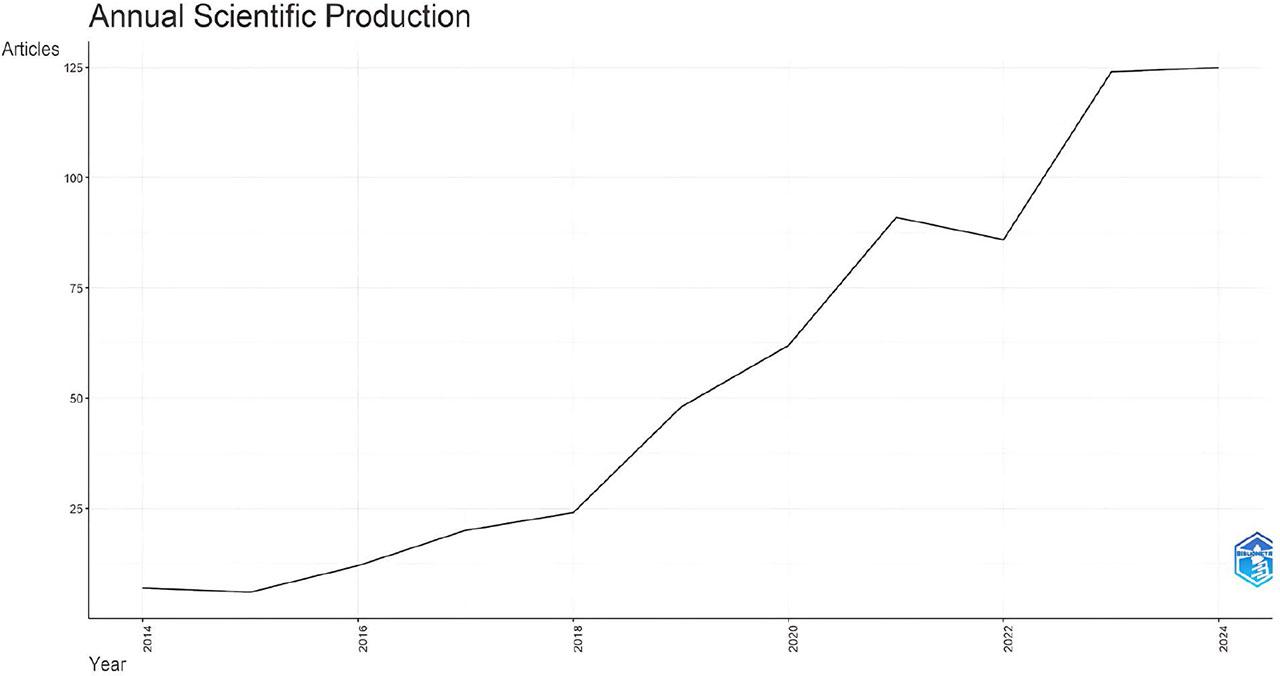
Annual scientific production (Source: Created by the author using Biblioshiny)
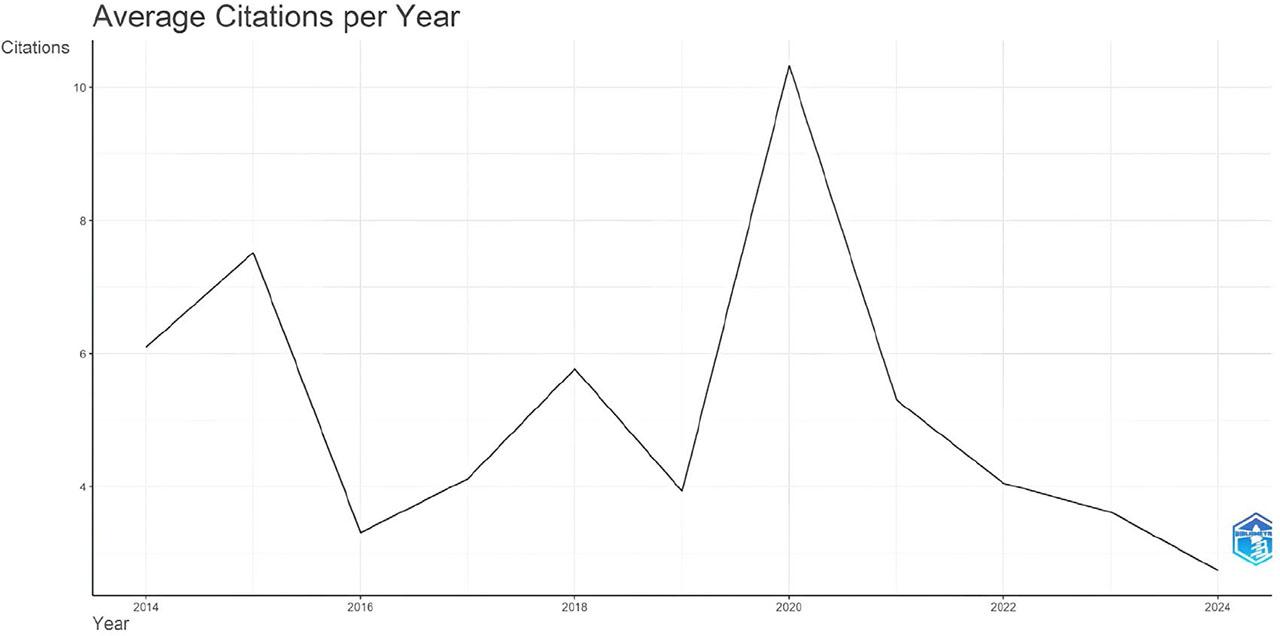
Average article citations per year (Source: Created by the author using Biblioshiny)
Figure 4a depicts the distribution of citations among the nations that have contributed to the field of mobile wallet research. India emerged as the major contributor with 2955 citations (equal to 36.78 % of total contributions), which means that the research in India is highly influential due to various contributing factors such as the demonetisation and the launch of UPI in 2016, which led to the rapid adoption of digital payment systems. Also, the Indian Government’s Digital India initiative further contributed to increased interest in this research area. India was followed by Malaysia with 1387 (17.26%), as Malaysia has the most mobile wallet users worldwide (Times, 2024). Spain ranks third with 1,335 citations (16.62%), which can be attributed to the widespread adoption of mobile payment systems like Bizum, which had over 27 million active users in 2024 (Poza, 2024). Although Spain ranks third, overall EU representation in mobile wallet research is low, likely due to the slower adoption of mobile payment technologies and a preference for card or cash payments (European Central Bank, 2024). Other influential contributors include China (931 citations), Jordan (471 citations), and the USA (322 citations). Though the USA is a global leader in card payment systems, it lags behind developing countries like China and Kenya in terms of mobile payment adoption (Han & Wang, 2021). This explains the reasons for the low representation of the USA in the mobile wallet bibliometric output. Figure 4b highlights the affiliations contributing the most articles to mobile wallet research. The University of Granada leads with 28 articles (18.54%), which can be attributed to the significant contributions of their professor, Francisco Liébana-Cabanillas, who has produced highly impactful papers on mobile wallets. UCSI University follows with 22 articles (14.57%) and Multimedia University with 20 articles (13.25%), both reflecting Malaysia’s strong research focus in this field. Collectively, these affiliations are important contributors to mobile wallet research, highlighting their strong engagement in this field.

Most cited countries (Source: Created by the author using Biblioshiny)
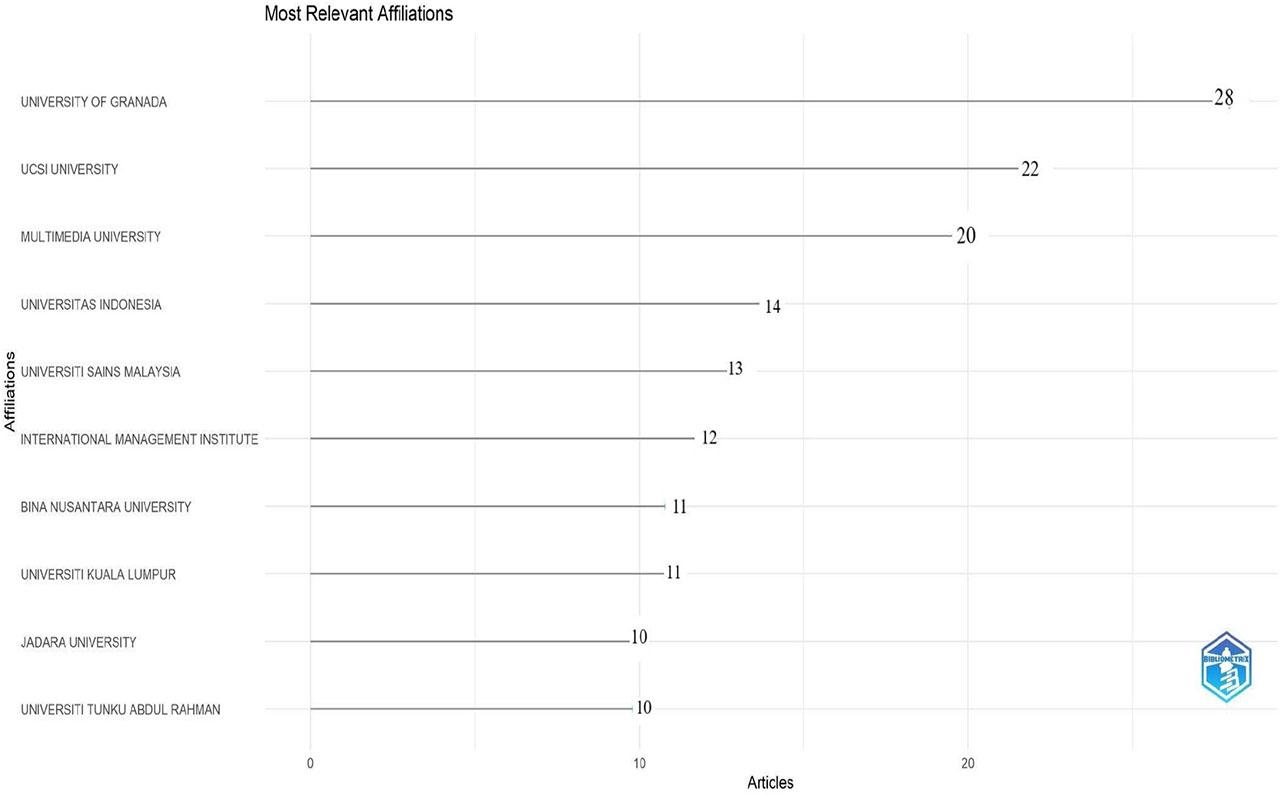
Most relevant affiliations (Source: Created by the author using Biblioshiny)
Figure 5a represents the notable authors who have contributed the most articles in mobile wallet research. Liébana-Cabanillas F is the leading author with 13 documents, followed by Chawla D and Joshi H, with 8 papers each. This shows that these researchers have been consistently involved in research in this area. Figure 5b depicts the authors’ Local Impact by H-index. It shows that Liébana-Cabanillas F ranks highest, with an H-index of 11, representing both productivity and citation impact. It is followed by Muñoz-Leiva F, with an index of 7. Al-Okaily M, Chawla D, and Joshi H follow closely, each with an H-index of 6. Based on the impact of total citations, Figure 5c illustrates that again Liébana-Cabanillas F ranks highest, with 1342 total citations, followed by Singh N with 866 citations, and Muñoz-Leiva F, who is placed third with 851 citations. High citation counts suggest that the works of these researchers have been highly influential and widely used by others. Figure 5d provides details of the research contributions of the notable authors from the years 2014 to 2024. It presents their publications and their citation impact. Liébana-Cabanillas F., Chawla, D., and Muñoz-Leiva F. are prominent leaders in the field, regularly publishing impactful research on mobile wallets. Researchers like Kapoor A. and Sindwani R. publish less frequently but occasionally produce impactful work.
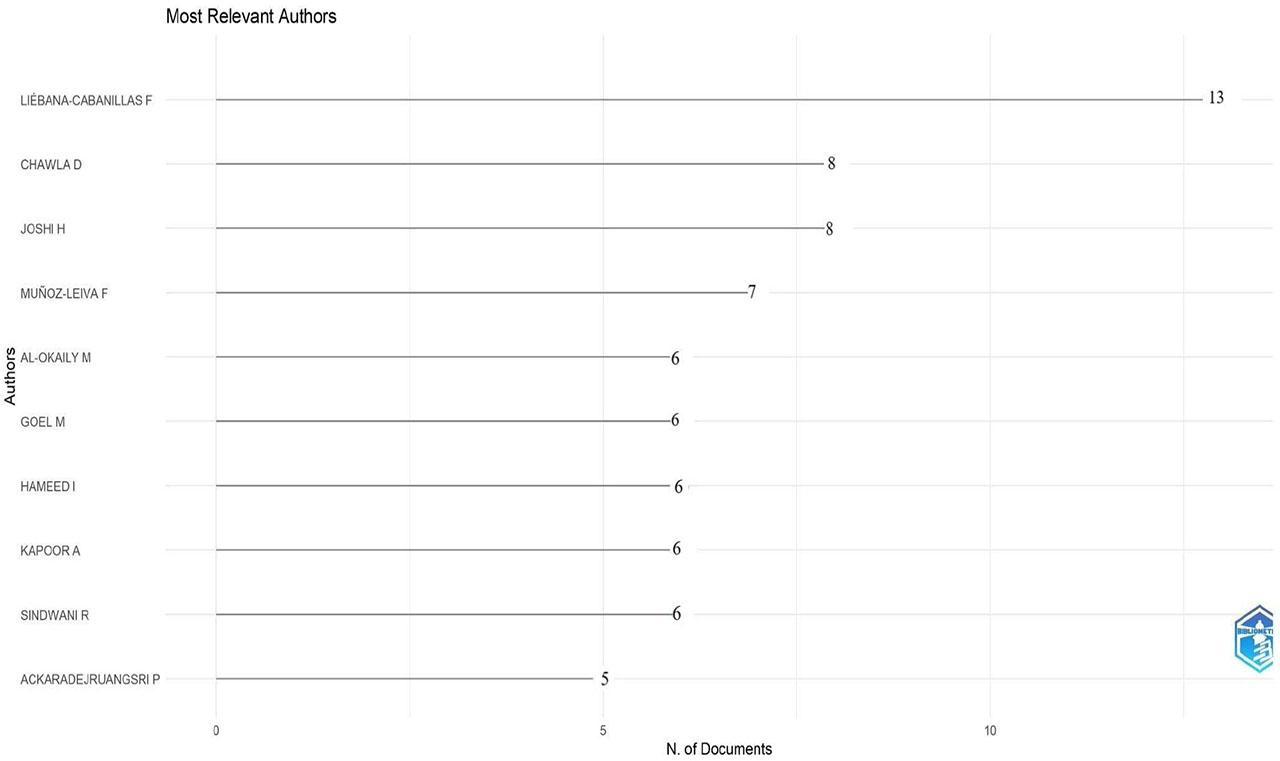
Most relevant authors (Source: Created by the author using Biblioshiny)

Author local impact by H-index (Source: Created by the author using Biblioshiny)
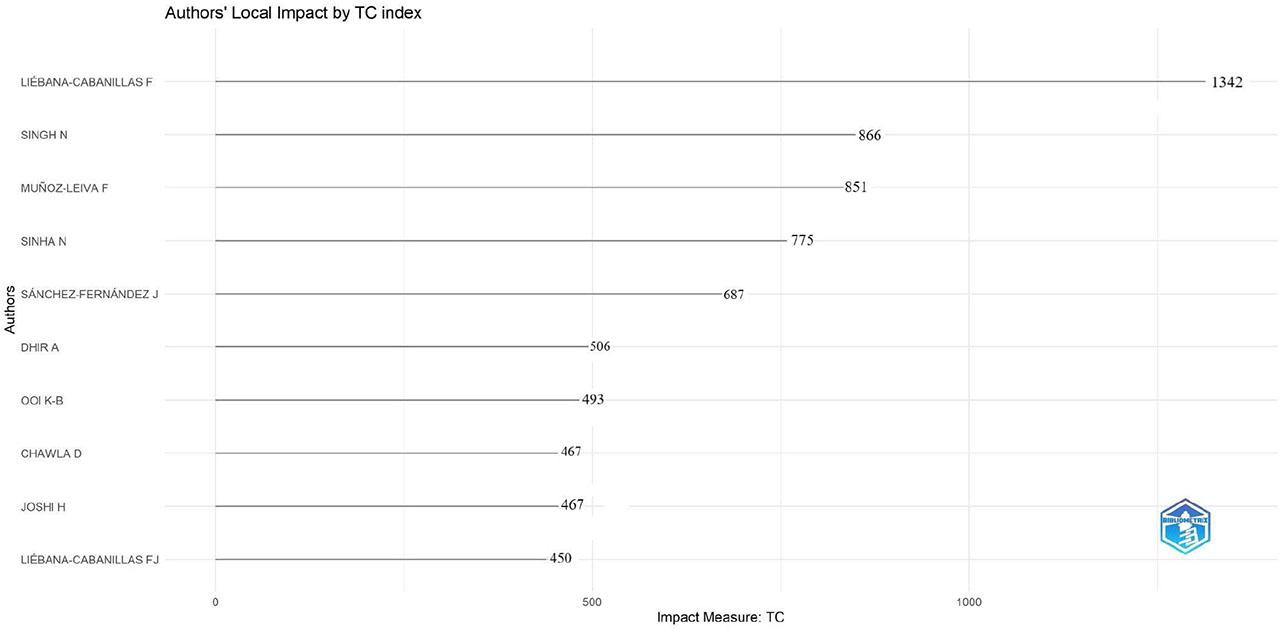
Author local impact by total citations (Source: Created by the author using Biblioshiny)

Top Author production over time (Source: Created by the author using Biblioshiny)
Figure 6 below presents the source analysis. The ten most popular journals in terms of the total number of documents are depicted in Figure 6a. The Journal of Retailing and Consumer Services is ranked first with 14 articles, followed by the International Journal of Bank Marketing (12 articles) and the Cogent Business and Management (11 articles). International Journal of Data and Network Science and Sustainability (Switzerland) follows closely with 10 publications each. This pattern suggests that mobile wallet research is positioned in journals focusing on marketing, sustainability and consumer behaviour. Also, the notable 10 journals in terms of citation index are depicted in Figure 6b. The Journal of Retailing and Consumer Services received the maximum number of citations (1518), followed by the International Journal of Information Management (1091 citations) and the International Journal of Bank Marketing (727 citations). Hence, we can conclude from the results that the Journal of Retailing and Consumer Services, the International Journal of Information Management and the International Journal of Bank Marketing will continue to contribute significantly to mobile wallet research. Similar insights are gathered from Figure 6c.
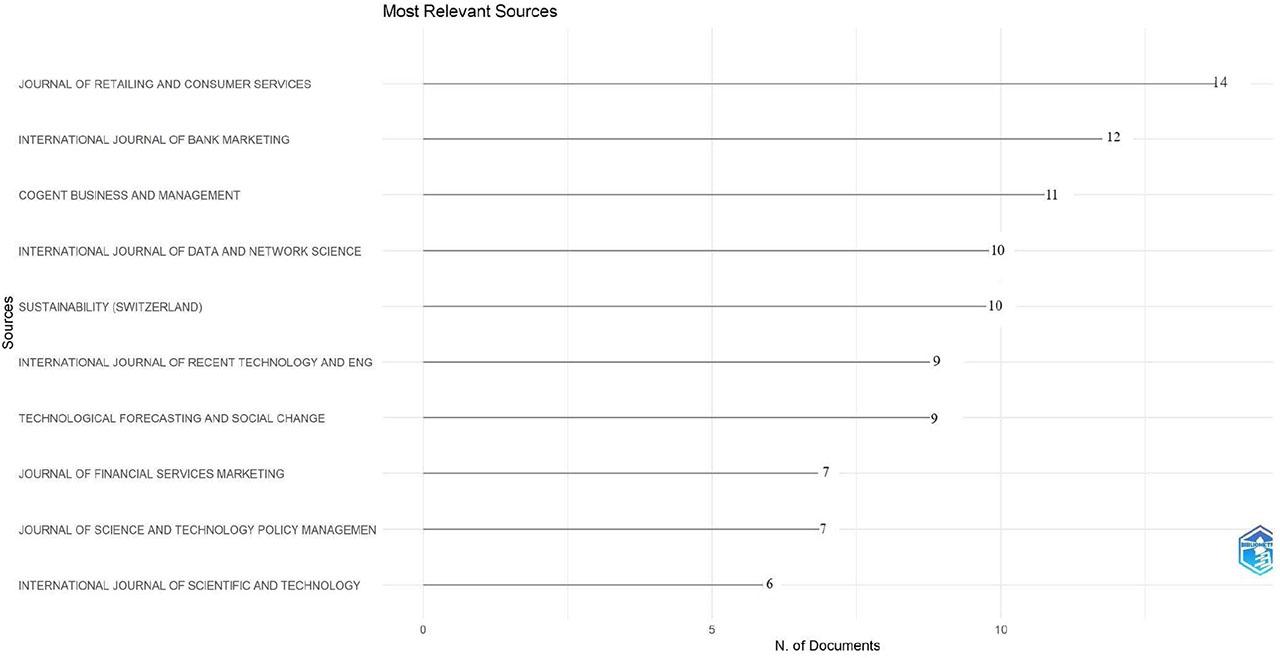
Most relevant sources (Source: Created by the author using Biblioshiny)

Source local impact (Source: Created by the author using Biblioshiny)
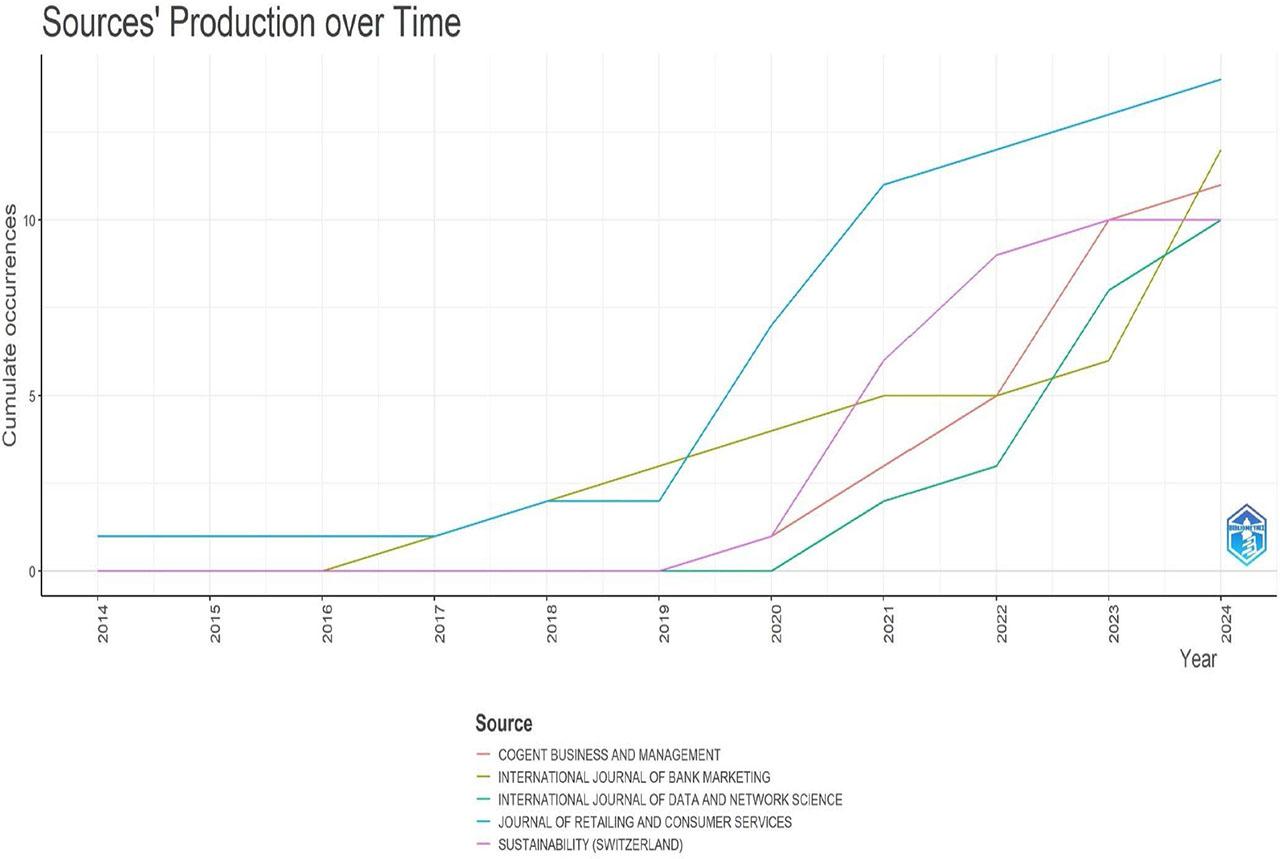
Sources’ production over time (Source: Created by the author using Biblioshiny)
Further, the relationship between countries, journals, authors, and institutions is presented in three-field plot figure 7a–c, which provides useful insights. For instance, studies are mostly published in Journals like Sustainability (Switzerland), International Journal of Bank Marketing, and Journal of Financial Services Marketing with Liébana-Cabanillas F., Hameed I., and Chawla D. as key contributing authors. Notable universities include Universitas Indonesia, Universiti Sains Malaysia, and the University of Granada. Overall, this relationship depicts that the mobile wallet research revolves around specific influential journals, authors and institutions, which together shape the direction and visibility of the field.

Countries–Journals–Institutions (Source: Created by the author using Biblioshiny)
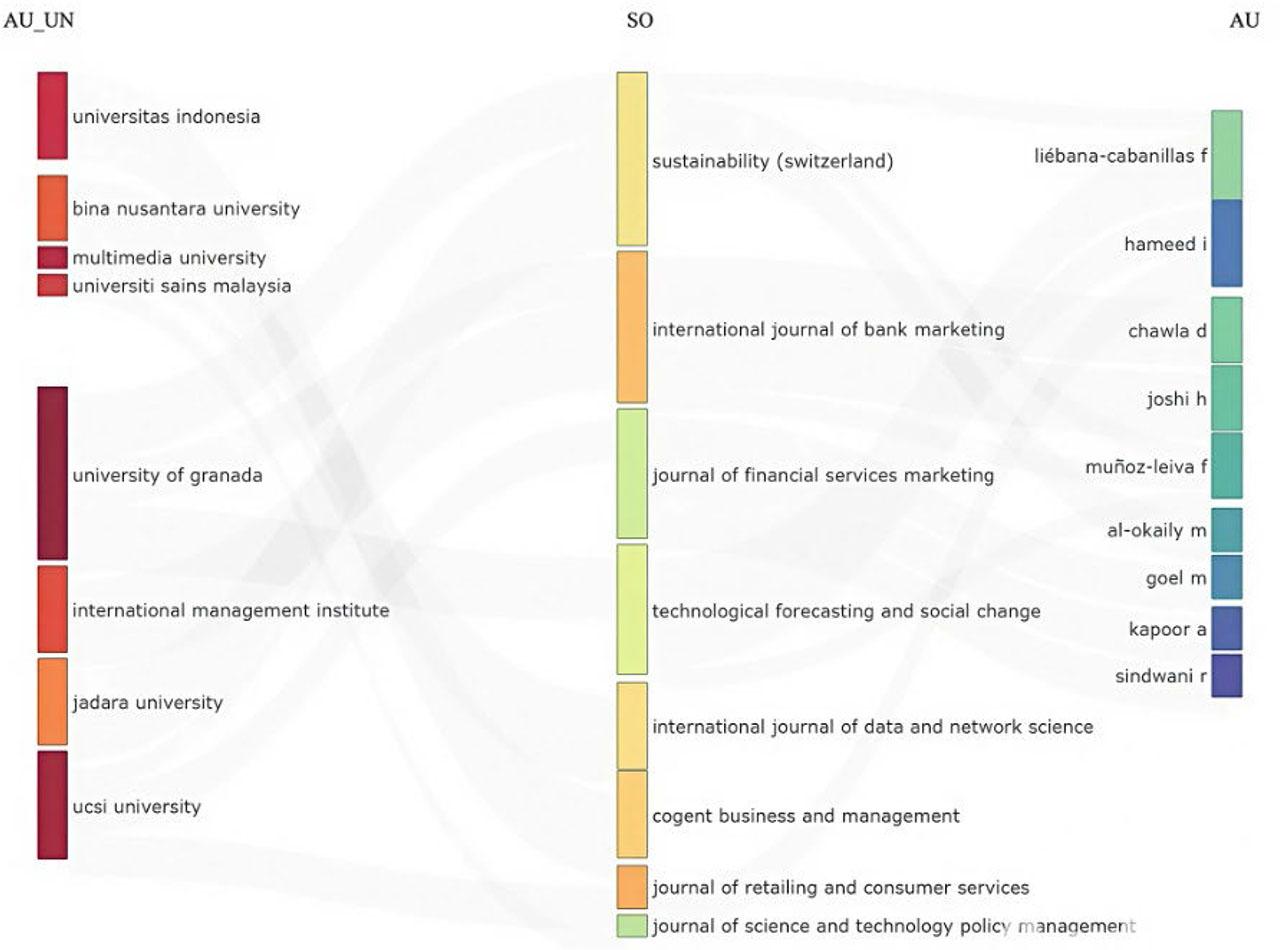
Institutions–Journals–Authors (Source: Created by the author using Biblioshiny)
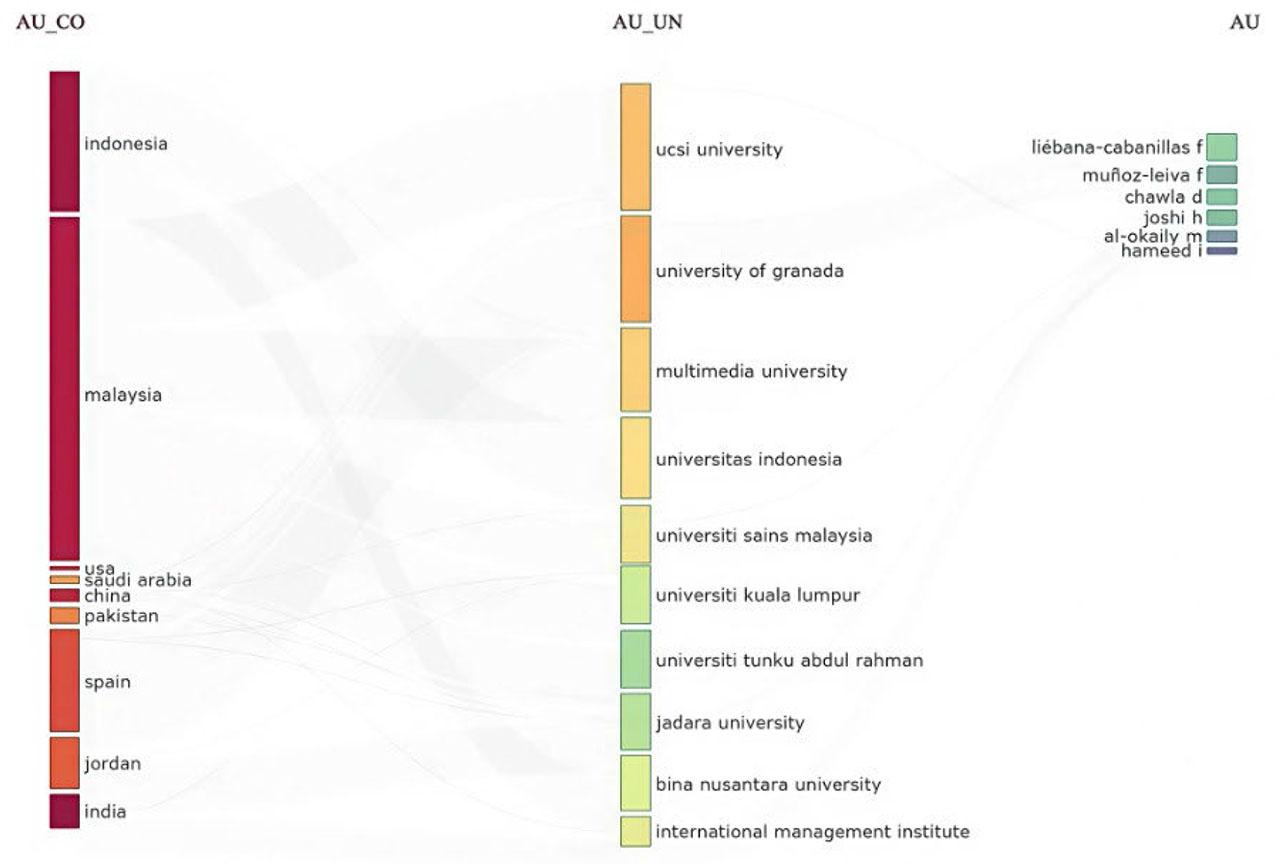
Countries-Institutions-Authors (Source: Created by the author using Biblioshiny)
The co-authorship network visualisation depicts the relationships among researchers engaged in mobile wallet research. As shown in Figure 8, each node represents an author, and the node size indicates the volume of contributions. The thickness of the lines depicts the strength of collaborations, with thicker lines depicting stronger collaborations. Authors are grouped into clusters based on their collaborations. Each cluster represents a distinct group of researchers frequently working together. For instance, Liébana-Cabanillas, Francisco is a notable contributor (large node and multiple connections) collaborating with several authors like Sánchez-Fernández, Juan and Muñoz-Leiva, Francisco.
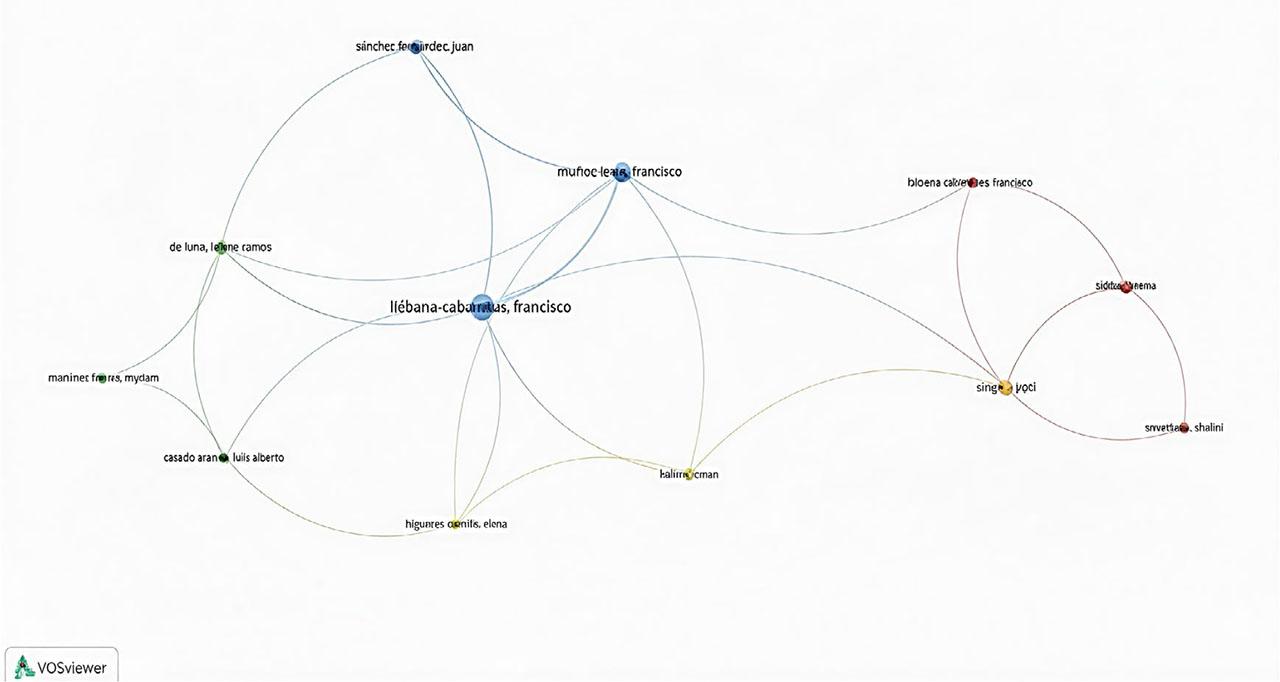
Author collaboration network (Source: Created by the author using VOSviewer)
As shown in Figure 9, each node represents a country. The node size depicts the volume of publications in mobile wallet research and the connecting lines between nodes represent the collaboration between countries. Groups of countries which often collaborate are represented through different clusters. As shown in Figure 8, India is a large central node representing a significant contributor to the research field. Countries like India, Indonesia, Malaysia, and the United States collaborate often and play a significant role in mobile wallet research.
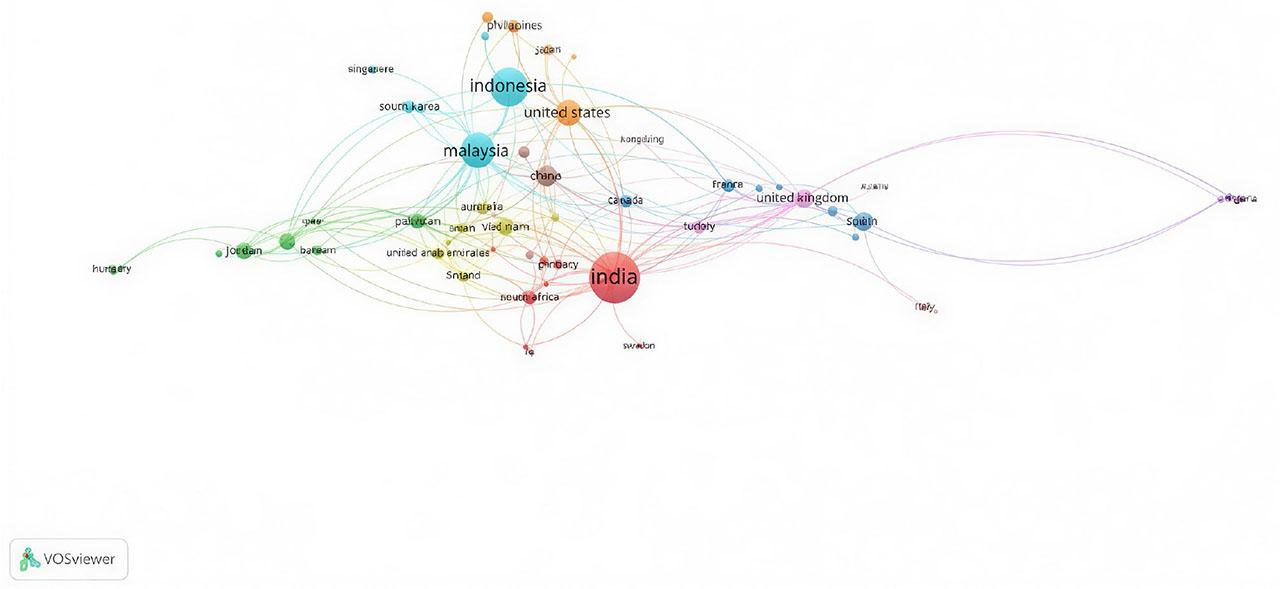
Country collaboration network (Source: Created by the author using VOSviewer)
Figure 10 visualises the co-occurrence of keywords in research articles. Each node represents a keyword, and the node’s size indicates its appearance frequency. The connections (edges) between nodes signify the co-occurrence of keywords in the same publication, with thicker edges denoting stronger co-occurrence relationships. Green Cluster represents keywords such as perceived usefulness, ease of use, and usage factors, highlighting studies conducted on user behaviour and technology acceptance. The red cluster includes keywords such as blockchain and cryptocurrency, highlighting their emerging role in digital wallet research. Further, the purple cluster covers keywords like trust, continuance intention, and satisfaction, reflecting research on adoption behaviours.

Co-occurrence network of keywords (Source: Created by the author using VOSviewer)
Figure 11 represents the co-citation network of articles, which indicates the research articles along with the citations. Every node depicts an article and its size indicates the total citations received by that article. Clusters are visualised using different colour combinations, grouping similar articles belonging to the same domain. Authors such as Sing (2020c), Shaw (2014), De Luna (2019a), and Leong (2020) are positioned centrally within their clusters, highlighting their significant contributions in their respective fields.
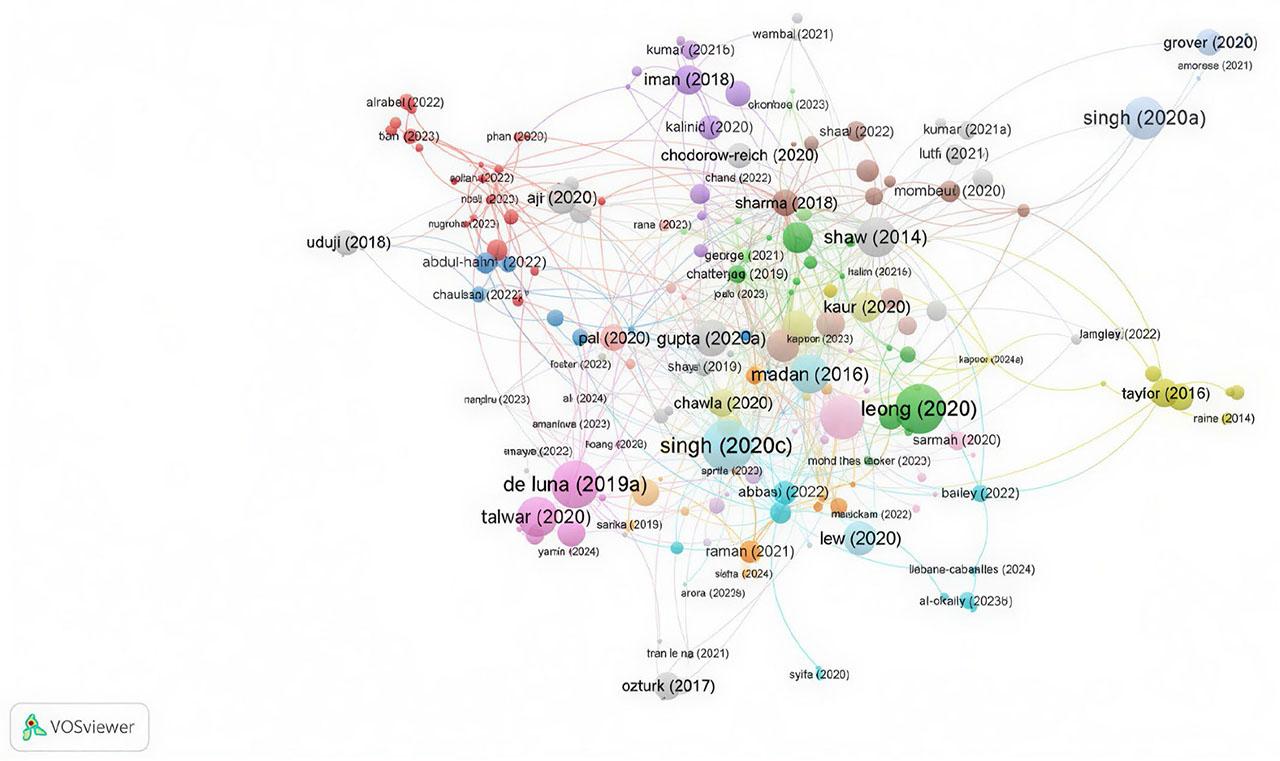
Article co-citation network (Source: Created by the author using VOSviewer)
Figure 12 depicts the author’s co-citation network. Every node represents an author, and its size indicates the frequency of their co-citations, with larger nodes signifying highly cited work. Clusters are visualised using different colour combinations, grouping similar articles belonging to the same domain. For example, the cluster dominated by Lieban-Cabanillas represents significant contributions in the field of technology adoption, while the group led by Chawla highlights work done in financial inclusion through mobile payments.
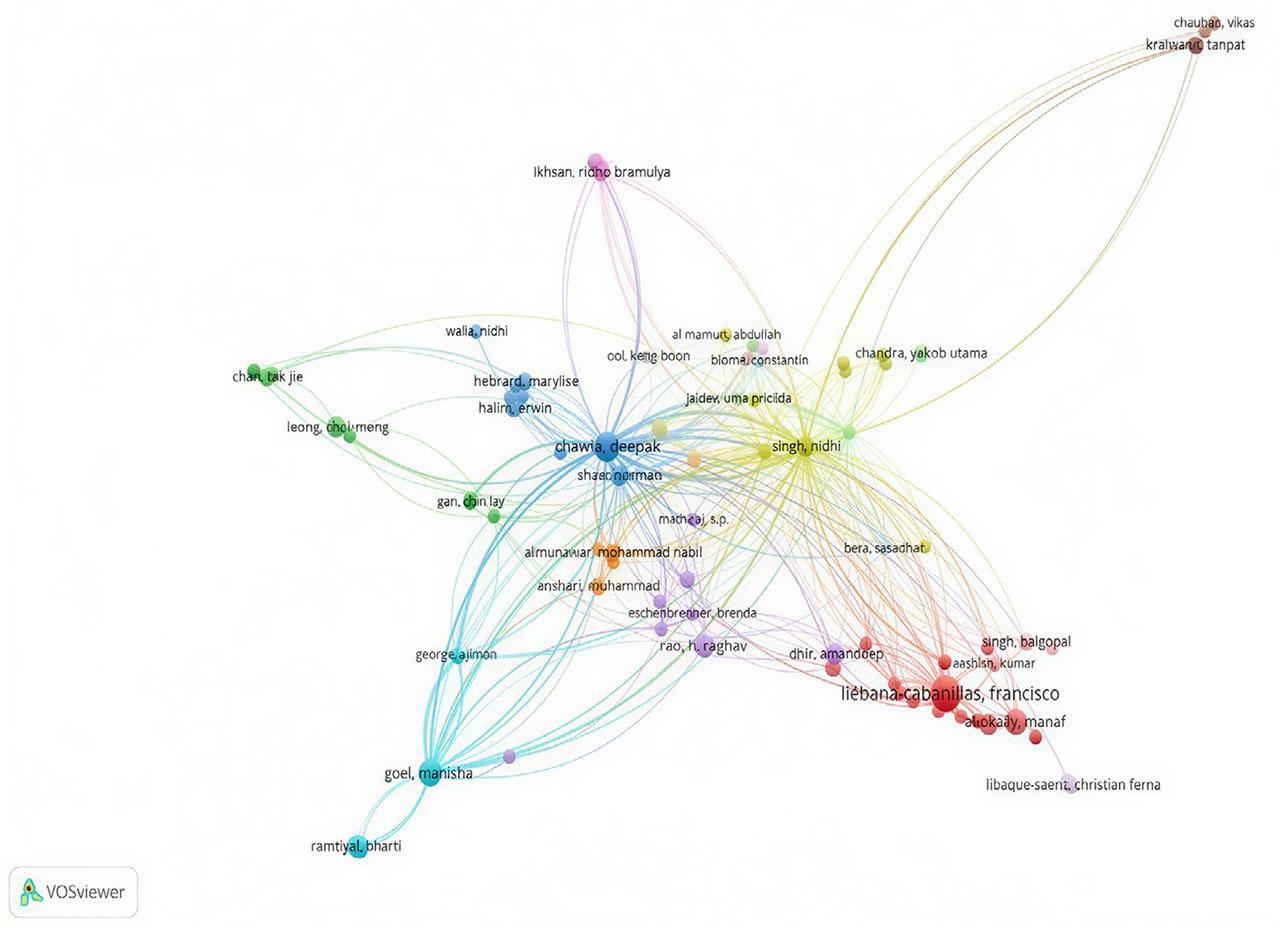
Co-authorship network of researchers (Source: Created by the author using VOSviewer)
This study aimed to review existing literature on mobile wallets. The study examined the landscape of mobile wallet research released between 2014 and 2024 as per the Scopus database and analysed the research performance in terms of annual scientific production, contributing authors, countries and affiliations, publication growth over the years, network visualisation, citations, co-citation network, keyword co-occurrence, high-impact journals and authors, etc.
Publications on mobile wallet research indicate a steady growth from 2014 to 2024, with a substantial rise after 2018, highlighting the increasing popularity of the research field among researchers during this period. There was a sharp increase in the number of citations in 2020, highlighting the growing popularity of the research area in the year 2020 due to the pandemic and the surge in the volume of digital transactions during this period. India emerged as the most contributing with 2955, followed by Malaysia and Spain, indicating a strong research focus in the regions where mobile wallet adoption has grown rapidly. In terms of contributing affiliations, the University of Granada leads as the major contributor of articles, followed by UCSI University and Multimedia University, reflecting the presence of highly influential researchers in these institutions who also rank highest in terms of H-index and total citations. In terms of the notable authors who have contributed the most articles in mobile wallet research, Liébana-Cabanillas F is the leading author, followed by Chawla D and Joshi H. Liébana-Cabanillas F also ranks highest in terms of authors’ Impact by H-index, representing both productivity and citation impact. The analysis of the sources highlighted that the Journal of Retailing and Consumer Services has the highest number of published articles in this field, highlighting its role in disseminating notable research in this area.
The co-authorship network revealed that Liébana-Cabanillas, Francisco is a notable contributor collaborating with several authors like Sánchez-Fernández, Juan and Muñoz-Leiva, Francisco. Further, the examination of the country’s collaboration network highlighted that India is a significant contributor to the research field. Countries like India, Indonesia, Malaysia, and the United States collaborate often and play a significant role in mobile wallet research. The co-occurrence graph of keywords highlights the key areas of focus in mobile wallet research, including user behaviour, technology acceptance, and adoption factors, alongside the emerging influence of blockchain and cryptocurrency. It also highlights the growing importance of trust, continuance intention, and satisfaction in understanding adoption behaviours. Further, the article co-citation network revealed that authors such as Singh (2020c), Shaw (2014), De Luna (2019a) and Leong (2020) are significant contributors in their respective fields. Lastly, the co-citation network analysis reveals key contributors in the field, with prominent authors such as Liébana-Cabanillas making significant contributions to technology adoption, while Chawla’s work leads the exploration of financial inclusion through mobile payments.
Overall, the findings revealed that mobile wallet research has grown rapidly, but the influence is not evenly distributed across regions. India emerged as a global leader driven by widespread adoption and supportive government initiatives, followed by countries such as Malaysia and Spain. In contrast, the United States remain underrepresented due to a slower adoption of mobile payment technologies and a preference for card or cash payments. At the institutional and author level, a few notable affiliations and authors, such as the University of Granada and Liébana-Cabanillas, have contributed significantly to this research area. Thematically, the field has been dominated by key areas such as user behaviour, technology acceptance, and adoption factors, but the growing interest in blockchain and cryptocurrency indicates a shift toward more advanced research directions. This uneven yet dynamic landscape suggests that although research on mobile wallets is becoming a worldwide phenomenon, regional variations in adoption and scholarly concentration continue to influence its course.
This study provides an extensive analysis of the research done on mobile wallet research and provides scope for future research. Nevertheless, it suffers from certain limitations. This study is limited to research articles indexed in the Scopus database. Though Scopus is believed to be a well-known database in the research community, other databases such as Web of Science and Dimensions are also important. Also, the bibliometric analysis of this study is done using Biblioshiny software and VOSviewer; other applications, such as SciMAT, CiteSpace, etc., are also capable of excellent visualisation techniques. Therefore, to further validate the current results, future research may use these competing tools.
This study provides a thorough summary of the research areas that scholars in mobile wallets have focused on. However, it is important to remember that these findings may evolve as new trends emerge and certain factors fluctuate in significance. Therefore, this study sets the path for further empirical research in the future.
